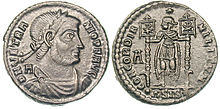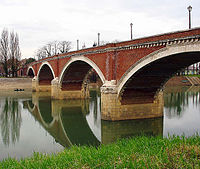|
Sisak
Sisak (pronounced [sǐːsak]; also known by other alternative names) is a city in central Croatia, spanning the confluence of the Kupa, Sava and Odra rivers, 57 km (35 mi) southeast of the Croatian capital Zagreb, and is usually considered to be where the Posavina (Sava basin) begins, with an elevation of 99 m. The city's total population in 2021 was 40,185 of which 27,886 live in the urban settlement (naselje).[7] Sisak is the administrative centre of the Sisak-Moslavina County, Croatia's biggest river port and a centre of river shipping industry (Dunavski Lloyd). It lies on the D36 state road and the Zagreb-Sisak-Novska railway. Sisak is a regional economic, cultural and historical center. The largest oil refinery in Croatia is here.[8] NamePrior to belonging to the Roman Empire, which gave it the Latin name Siscia, the region was Celtic and Illyrian and the city there was named Segestica[9] or Segesta.[10] Writers in Greek referred to the city as Ancient Greek: Σισκία, romanized: Siskía, Σεγέστα, Segésta, and Σεγεστική, Segestikḗ.[10] In German the town is known as German: Sissek, Hungarian: Sziszek [ˈsisɛk], and in Kajkavian and Slovene as Slovene: Sisek. HistoryRoman empire Siscia is described by Roman writers as a great town in the south of Upper Pannonia, on the southern bank of the Savus, on an island formed by that river and two others, the Colapis and Odra, a canal dug by Tiberius completing the island.[10] It was on the great road from Aemona to Sirmium.[11] According to Pliny the name Segestica belonged only to the island, and the town was called Siscia; while Strabo says that Siscia was a fort in the neighbourhood of Segestica;[12] but if this was so, it must be supposed that subsequently the fort and town became united as one place. Siscia was from the first a strongly fortified town; and after its capture by Tiberius, in the reign of Augustus,[13] it became one of the most important places of Pannonia; for being on two navigable rivers, it not only carried on considerable commerce,[14] but became the central point from which Augustus and Tiberius carried on their undertakings against the Pannonians and Illyrians. Tiberius did much to enlarge and embellish the town, which as early as that time seems to have been made a colonia, for Pliny mentions it as such: in the time of Septimius Severus it received fresh colonists, whence in inscriptions it is called Col. Septimia Siscia. The town contained an imperial mint, which produced coins under a series of emperors between 262 and 383 AD.[15] The Christian martyr Quirinus of Sescia, presumed the first bishop of the Diocese of Sescia, was tortured and nearly killed during Diocletian's persecution of Christians. Legend has it that they tied him to a millstone and threw him into a river, but he freed himself from the weight, escaped and continued to preach his faith. Today he is the patron saint of Sisak. When Diocletian split Pannonia into four provinces, Siscia became the capital of Pannonia Savia, the southwestern one, for which Siscia contained the treasury; at the same time it was the station of the small fleet kept on the Savus. Siscia maintained its importance until Sirmium began to rise, for in proportion as Sirmium rose, Siscia sank and declined.[10] Middle AgesBraslav of Lower Pannonia reigned from Sisak until he was killed in the Hungarian invasion ca. 898.[16] According to Historia Salonitana, Duke Tomislav reclaimed it soon after.[17][18] Early modern The 16th-century triangular fortress of the Old Town, well-preserved and turned into the Native Museum, is the main destination of every tourist. The fortress is famous for the victory of the joint forces of Croats, Austrians and Carniolans (Slovenes) over the Ottomans in 1593, known as the Battle of Sisak. It was one of the early significant defeats of the up-to-then invincible Ottoman army on European territory. The Croatian Ban Thomas Erdődy who led the defense in this battle became famous throughout Europe. However this victory didn't prevent Sisak from Ottoman conquest on 24 August 1593. During their brief rule, it was called Siska. Its fortress was manned, a sanjak beg was appointed and a mosque was built in the fortress.[19] On 11 August 1594, Ottoman forces fled and set the fortress on fire after a powerful Habsburg-Croat army approached.[20] The Baroque palace of Mali Kaptol, the classicist Veliki Kaptol, the brick Stari most ("Old Bridge") over the Kupa, and the ethnological park are the most frequently visited landmarks. ModernIn the late 19th and early 20th century, Sisak was a district capital in the Zagreb County of the Kingdom of Croatia-Slavonia. Modern history From 1929 to 1939, Sisak was part of the Sava Banovina, and from 1939 to 1941, of the Banovina of Croatia within the Kingdom of Yugoslavia. During World War II, the Sisak children's concentration camp was set up by the Croatian Axis Ustaše government for Serbian, Jewish and Romani children. It is estimated that 1,160–1,600 children lost their lives at the camp.[21][22] On 22 June 1941, the day Germany invaded the Soviet Union, the Sisak People's Liberation Partisan Detachment, also known as the 1st Sisak Partisan Detachment, was formed by the outlawed Croatian Communist Party in the Brezovica Forest, near Sisak. It was the first Partisan armed anti-fascist resistance unit formed in occupied Yugoslavia following the invasion of Yugoslavia by the Axis powers in April 1941.[23] It had 79 members, mainly Croats with the exception of one notable Serb woman, Nada Dimić,[23] and was commanded by a Croat, Vladimir Janjić-Capo. With the outbreak of the Croatian War of Independence in 1991, Sisak remained in Government hands while the territory to the south was controlled by rebelling Serbs. During the war, the Serb forces often shelled the city, causing dozens of civilian casualties and extensive damage to the city's industry.[24] According to Amnesty International, Serb civilians in Sisak and surrounding areas were subjected to abductions, killings, assault and threats with at least 33 killed between 1991 and 1992,[25] while local human rights activists in Croatia claim that over 100 Serb residents of the Sisak region were killed during the entirety of the war.[26] The frontline dramatically moved eastwards as a result of Operation Storm (1995), effectively ending the war. Sisak suffered much damage during the 2020 Petrinja earthquake.[27] The town, located roughly 20 km (12 mi) northeast of the epicenter, reported damage to the hospital as well as city hall and various churches.[28][29] Most of the damage was inflicted on old buildings in the center of the town. However, early figures estimate that 700 to 1,000 homes were damaged in Sisak and nearby villages.[30] PopulationIn the 2011 census, of the total population of 47,768 there were 40,590 Croats (84.97%), 3,071 Serbs (6.43%), 1,646 Bosniaks (3.45%), 648 Romani (1.36%), 179 Albanians (0.37%), 29 Montenegrins (0.06%), and the rest were other ethnicities. In the 2011 census, the population by religion was 37,319 Roman Catholics (78.13%; since 2009 again served by their own Diocese of Sisak), 3,279 Orthodox Christians (6.86%), 2,442 Muslims (5.11%) and others. City of Sisak: Population trends 1857–2021
Municipal makeupThe city's administrative area is composed of the following settlements:[7]
Administrative divisionThe administrative sections of Sisak are the city neighboorhoods (gradske četvrti) and local administrative boards (mjesni odbori). The city neighborhoods are:[31] The local administrative boards are:[31]
PoliticsMinority councils and representativesDirectly elected minority councils and representatives are tasked with consulting tasks for the local or regional authorities in which they are advocating for minority rights and interests, integration into public life and participation in the management of local affairs.[32] In the most recent election to the Sisak ethnic minority council, the local Bosniak, Roma, and Serb minorities each fulfilled the legal requirements to elect a total of 15 deputies to the minority council of the City of Sisak; while the local Albanian minority elected a representative.[33] Miscellaneous Chief occupations are farming, ferrous metallurgy (iron works), chemicals, leather (footwear), textiles and food processing plants (dairy products, alcoholic beverages), building material, crude oil refinery and thermal power. Sisak features the largest metallurgic factory and the largest oil refinery in Croatia. Sisak has many rich mineral springs (spas) with healing properties in the temperature range from 42 to 54 °C (108 to 129 °F). The city hosts University of Zagreb's Faculty of Metallurgy. Sports and recreation facilities in the town and the surroundings include mainly the waters and alluvial plains a public beach on the Kupa. All rivers (Kupa, Odra, Sava) with their backwaters offer fishing opportunities. There are hunting grounds in the regions of Turopolje and Posavina. Sisak is the starting point for sightseeing tours into Lonjsko Polje (Field of Lonja river) nature park. The local football club is HNK Segesta. Sisak features the oldest ice hockey club in Croatia, KHL Sisak est. 1934.[citation needed] GeographyClimate
International relations Twin towns – Sister citiesSisak is twinned with:
See alsoReferencesBibliography
Notes
External linksWikimedia Commons has media related to Sisak. Wikivoyage has a travel guide for Sisak.
|
||||||||||||||||||||||||||||||||||||||||||||||||||||||||||||||||||||||||||||||||||||||||||||||||||||||||||||||||||||||||||||||||||||||||||||||||||||||||||||||||||||||||||||||||||||||||||||||||||||||||||||||||||||||||||||||||||||||||||||||||||||||||||||||||||||||||||||||||||||||||||||||||||||










